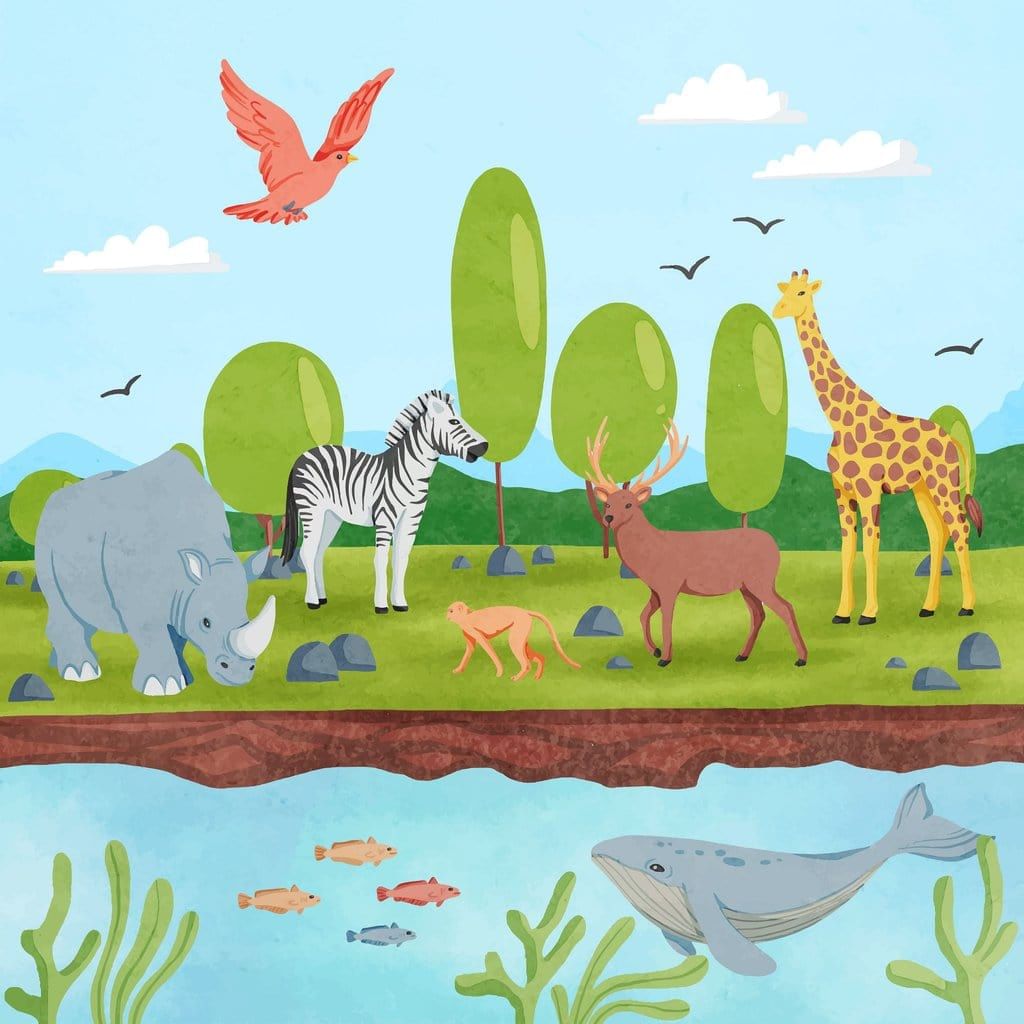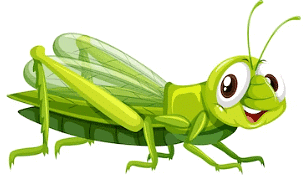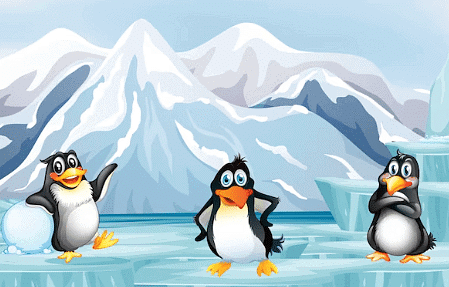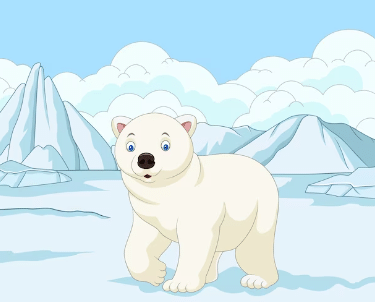Class 5 Science - Animal Habitat and Adaptation - Question Answers
Q1: Define Habitat and Adaptation.
Ans:
Habitat: A habitat is the natural home or environment where an animal, plant, or organism lives. It's like their "Neighbourhood" or "house". Habitats provide everything an animal needs to survive, such as food, water, shelter, and suitable living conditions.
Adaptation: Adaptation is the process by which animals, plants, and organisms change or develop special features to survive and thrive in their habitats.
 Animal LifeQ2: What does a habitat provide to an animal?
Animal LifeQ2: What does a habitat provide to an animal?
Ans: A habitat is a place where an animal lives. It provides everything an animal needs to survive and grow such as:
- Shelter: A habitat that gives animals a safe place to live and hide from predators. It provides them with protection from extreme weather conditions like rain, sun, and cold.
- Food: Habitats provide animals with a source of food. Different habitats have different types of food available. For instance, forests provide nuts, fruits, and insects, while oceans provide fish and other marine creatures.
- Water: Water is essential for the survival of animals. Habitats like lakes, rivers, and ponds provide water for animals to drink and bathe in.
- Oxygen: Just like humans, animals need oxygen to breathe. Habitats such as forests and grasslands have plants that produce oxygen through a process called photosynthesis. Animals inhale this oxygen to stay alive.
- Space: Habitats offer animals enough space to move around and find what they need. Some animals require large territories to find food or mates, while others need smaller spaces.
- Suitable climate: Habitats provide animals with a climate that suits their needs. Some animals prefer hot climates, while others thrive in colder environments.
Q3: Name any three breathing organs in animals.
Ans: The three breathing organs in animals are:
- Lungs: Lungs are the breathing organs found in many animals. Lungs help animals breathe in oxygen and breathe out carbon dioxide.
- Gills: Gills are breathing organs found in many aquatic animals such as fish. They are located on the sides of the fish's head, behind the gill covers.
- Spiracles and Tracheae: Some insects, like grasshoppers, have a different type of breathing system. They have small openings called spiracles on the sides of their bodies.
 Grasshopper
Grasshopper - These spiracles connect to a network of tiny tubes called tracheae, which extend throughout the insect's body.
- Air enters the spiracles and travels through the tracheae, delivering oxygen directly to the cells.
Q4: Describe the different types of habitats listing their special features.
Ans: The different types of habitats are:
(i) Forest:
- It is a large area that is covered by trees and plants. Forest provides shelter to a large number of animals.
- For example – lion, tiger, monkey etc.
(ii) Desert:
- A desert is a dry, often sandy region that receives very little rainfall. It is usually very hot during the day and very cold during the night.
- Water is hard to find in deserts. Animals found in deserts are Camel, rattlesnakes and ground squirrels.
(iii) Polar Regions and Mountains:
- The polar regions – Antarctica and the Arctic and high mountains are extremely cold and covered with snow.
- Penguins, seals and Walrus are found in Polar regions.
 Penguins in Polar regions(iv) Ocean:
Penguins in Polar regions(iv) Ocean:
- The ocean is a large, continuous body of salt water that covers two-thirds of the earth’s surface.
- It is the world’s largest habitat.
- It is divided into the Pacific Ocean, Atlantic Ocean, Indian Ocean, Arctic Ocean and Southern Ocean.
- A large variety of fish are found in the ocean such as Whales, octopuses and jellyfish are a few to name.
(v) Fresh Water:
- Rivers, Lakes and Ponds are examples of freshwater habitats.
- Some animals live in water for example fish and shrimp.
- Some animals live both on land and water they are called amphibians for example frogs and salamanders.
Q5: Describe the different body coverings of animals with examples.
Ans: The different body coverings of animals are:
(i) Scales:
- Fish are covered with a layer of flexible, overlapping scales.
- The bodies of reptiles like snakes, crocodiles and lizards too are covered with scales.
- Most reptiles have horny scales that prevent water loss from their bodies.
(ii) Shell:
- Animals like snails, tortoises and turtles are protected by a shell.
- These animals withdraw their head and feet into the shell when they sense danger.
(iii) Wool or Fur:
- Mammals like sheep and bears have special body coverings.
- A sheep’s body is covered with wool and a bear’s body is covered with fur. These coverings protect them from rain and cold.
 Polar Bear (iv) Feathers:
Polar Bear (iv) Feathers:
- Birds are covered with feathers.
- Feathers help them to fly. They also protect the birds from rain and cold.
Q6: Explain how animals are adapted to move in different ways.
Ans: Different types of animals have different types of organs to move like:
- Animals like dogs and cats move with the help of their legs.
- Birds fly with the help of their wings.
- Most snakes move with the help of scales on the underside of their body.
- Fish, dolphins and whales swim with the help of fins.
- Penguins and seals have flippers which help them to swim.
- Frogs hop around using their strong back legs. Their webbed feet help them to swim.
Q7: Define Moulting, Camouflage, and spiracles.
Ans:
Moulting:
- Moulting is a process in which animals shed or replace their outer covering, such as feathers, and skin to allow for growth and renewal.
- It is like when you shed old clothes and wear new ones.
- During moulting, the old covering is replaced with a new one.
- For example, snake shed their skin periodically and these are replaced by new ones.
Camouflage:
- Camouflage is a way for animals to blend in or hide in their surroundings.
- Camouflage allows animals to match the colours, patterns, and textures of their environment, making it difficult for others to see or notice them.
- It helps them stay protected from predators or become better hunters. For example, chameleon
Spiracles:
- Insects breathe with the help of a series of tiny holes along the side of their bodies. These holes are called spiracles.
- Spiracles are like little entry points for air to reach the insect's respiratory system, allowing them to breathe.
- For example, spider and Indian moon moth.
|
43 videos|371 docs|45 tests
|
FAQs on Class 5 Science - Animal Habitat and Adaptation - Question Answers
| 1. What is the definition of a habitat? |  |
| 2. How do animals adapt to their habitat? |  |
| 3. What happens if an animal is not well-adapted to its habitat? |  |
| 4. How do different habitats affect animal species? |  |
| 5. What are some examples of animal adaptations to specific habitats? |  |






















